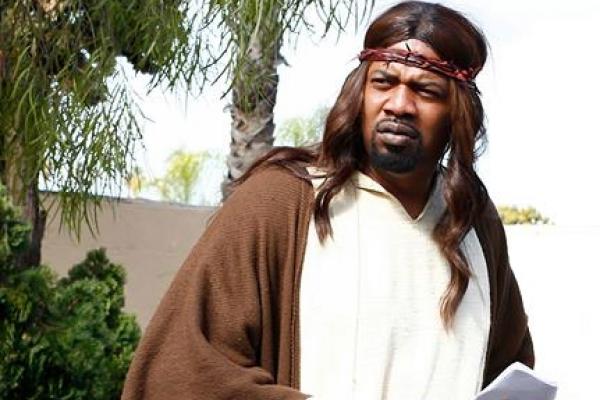JESUS RETURNED this past August. Or at least a new depiction of him appeared on late-night cable television, in the comedy Black Jesus, created by Aaron McGruder (of The Boondocks). There was no rapture, and no subsequent tribulation, beyond what passes for normal these days. Instead Jesus appeared, as he did in Palestine, in a manner both obscure and mysterious. And, again, his incarnation became a scandal among some of the powerful and pious.
In Black Jesus, on the Adult Swim network, the second person of the Trinity turns up one day on the streets of Compton, a very poor and heavily African-American community in southern Los Angeles County. Played by a tall and beefy Gerald “Slink” Johnson, Jesus walks the streets in his first century robe and sandals, but with his hair in a Tina Turner perm. Aside from the eccentric get-up, this Jesus fits right into his surroundings. He has no cash, and no place to lay his head. But that goes for plenty of Comptonites. He enjoys malt liquor and marijuana, just as much as he did good wine back in the day at Cana. He’s still preaching and practicing unconditional love, forgiveness, nonviolence, and service to all, but his street talk averages about 1.5 bleeps per sentence.
There’s plenty that’s problematic about Slink Johnson’s character. For one thing, I can’t imagine the Jesus I know using the disrespectful canine term for women so freely or being quite so nonjudgmental about the marijuana trade. But neither does this depiction approach “blasphemy,” which is what the American Family Association called it. The Catholic League, which often leads the charge against perceived offenses to the faith, got it about right when it said, “The Jesus character in this show is a mixed bag: He is irreverent and can be downright crude, but he also has many redeeming qualities.”
I caught the first few episodes of Black Jesus during those hot August days when Michael Brown, an unarmed young black man, had just been shot like a dog in the streets of Ferguson, Mo. In that context, it didn’t seem strange that Jesus would want to identify with unemployed young African Americans and offer them his love, solace, and support. They are, after all, perhaps the most disenfranchised, discouraged, and endangered people in the U.S. In McGruder’s show, that’s what Jesus does. A small posse of young people is drawn to him. They include the young son of a major pot dealer, a fellow who’s been in and out of jail, a bespectacled nerd, and a Facebook-obsessed young woman named Maggie (short for Magdalene?).
Yes, McGruder’s Jesus shares in his people’s folkways and small pleasures, but he also challenges their prejudices, violence, and self-seeking. He promotes “black-Latin” reconciliation and tries to turn his young apostles toward a life of positive community service.
As I watched Black Jesus, I kept thinking about the Cotton Patch New Testament written by biblical scholar and Koinonia Farm founder Clarence Jordan. He did a faithful translation from the Greek into lively Southern English and set the story in the Deep South of the 1960s. Jerusalem was Atlanta. Gentiles were African Americans, and Jews were “good white folk.” The Acts of the Apostles came out sounding a lot like the early 1960s travails of Southern civil rights workers. In the gospel of John, the Word of God didn’t come to dwell among us; it parked its trailer next to ours.
Aaron McGruder is no Clarence Jordan. And Black Jesus is, first and foremost, a comedy. But there are moments in the show when I thought I caught a sideways glimpse of the true Christ. He may never replace that Italian Renaissance Jesus above the altar, but Black Jesus is real religious art, nonetheless.

Got something to say about what you're reading? We value your feedback!
